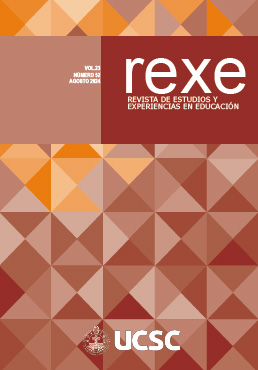Deserción y (re)ingreso a la docencia de aula en Chile entre 2021-2022
DOI:
https://doi.org/10.21703/rexe.v23i52.2369Palabras clave:
Profesor, Política docente, Pandemia, Escasez de doentes, ChileResumen
Aunque las trayectorias docentes tienen un papel importante en la agenda gubernamental de educación y en la agenda investigativa, las diferentes publicaciones nacionales no han examinado el período post implementación de la Ley de Carrera Docente y la crisis por COVID-19 en el marco de la puerta giratoria, un fenómeno que se produce entre quienes desertan y (re)ingresan al aula y que ayuda a invisibilizar el déficit docente. Así, buscando aportar a esa reflexión, el objetivo fue examinar el abandono anticipado de la carrera y el (re)ingreso al aula de docentes entre 2021-2022, según la dependencia administrativa de los establecimientos educativos. Respecto a la metodología, el enfoque fue cuantitativo, el diseño descriptivo, la muestra fueron docentes de aula de la educación parvularia, básica y media en la educación regular y no jubilados y se usó estadística descriptiva sobre la Base de Cargo Docente. Los resultados evidencian una 9,1% de deserción y 11,5% de (re)ingreso, así como un menor efecto de la Ley de Carrera Docente, al menos durante el segundo año de la pandemia y hasta su entrada en régimen el 2025. Las conclusiones invitan a responder a este desafío con atracción a la carrera de pedagogía y retención de quienes ya ejercen la docencia, especialmente en grupos específicos como los docentes con más años de experiencia en establecimientos particulares subvencionados y quienes poseen título en educación entre los establecimientos municipales.
Descargas
Referencias
Ávalos, B., y Valenzuela, J. P. (2016). Education for all and attrition/retention of new teachers: A trajectory study in Chile. International Journal of Educational Development, 49, 279-290. https://doi.org/10.1016/j.ijedudev.2016.03.012 DOI: https://doi.org/10.1016/j.ijedudev.2016.03.012
Bacher-Hicks, A., Chi, O. y Orellana, A. (2023). Two years later: how COVID-19 has shaped the teacher workforce. Educational Research, 52(4), 219–29. https://doi.org/10.3102/0013189X231153659. DOI: https://doi.org/10.3102/0013189X231153659
Borman, G. y Dowling, N. (2008). Teacher attrition and retention: a meta-analytic and narrative review of research. Review of Educational Research, 78(3), 367–409. http://dx.doi.org/10.3102/0034654308321455 DOI: https://doi.org/10.3102/0034654308321455
Brandenburg, R., Larsen, E., Simpson, A. Sallis, R. y Trần, D. (2024). ‘I left the teaching profession… and this is what I am doing now’: a national study of teacher attrition. The Australian Educational Researcher, 1-20. https://doi.org/10.1007/s13384-024-00697-1 DOI: https://doi.org/10.1007/s13384-024-00697-1
Cabezas, V., Gallego, F., Santelices, V. Zarhi, M. (2013). Factores correlacionados con las trayectorias laborales de docentes en Chile, con especial énfasis en sus atributos académicos. Proyecto FONIDE N° FS511082- 2010. Santiago de Chile, Ministerio de Educación. Disponible en: https://centroestudios.mineduc.cl/wp-content/uploads/sites/100/2017/07/Informe-Final-Veronica-Cabezas-PUC-511082.pdf
Carrasco, D., Godoy, M. y Rivera, M. (2017). Rotación de profesores en Chile. Quienes son y cuales es el contexto de quienes dejan su primer trabajo. Midevidencias, 11, 1-7. Disponible en: https://mideuc.cl/wp-content/uploads/2022/11/MidEvidencias-N11.pdf
Carrasco, D., Manzi, J. y Treviño, E. (2018). Trayectorias laborales de los docentes: ¿dónde, cuándo y bajo qué condiciones dejan su primer trabajo?. Temas de la Agenda Pública, 13(105), 1-20. Disponible en: https://politicaspublicas.uc.cl/publicacion/trayectorias-laborales-de-los-docentes/
Carver-Thomas, D. y Darling-Hammond, L. (2017). Teacher turnover. Why it matters and what we can do about it. Palo Alto: Learning Policy Institute. Disponible en: https://learningpolicyinstitute.org/product/teacher-turnover-report DOI: https://doi.org/10.54300/454.278
Centro de Investigación Avanzada en Educación [CIAE] (9 de abril, 2021). El 20% de profesores se retira en los primeros 5 años de vida laboral y las especialidades más críticas son educación parvularia y media. Santiago de Chile, CIAE.
Cols, E. (2008). La formación docente inicial como trayectoria. Ciclo de desarrollo profesional de directores. Bogotá́: INFD.
Díaz, A., López, D., Salas, M. y Carrasco, D. (2021). Movilidad de profesores chilenos. Influencia de variables demográficas, características del establecimiento escolar y condiciones laborales. Perfiles Educativos, 43(172), 42-59. https://doi.org/10.22201/iisue.24486167e.2021.172.59514 DOI: https://doi.org/10.22201/iisue.24486167e.2021.172.59514
Diliberti, M., Schwartz, H. y Grant, D. (2021). Stress topped the reasons why public-school teachers quit, even before COVID-19. Santa Mónica: Rand Corporation. Disponible en: https://www.rand.org/pubs/research_reports/RRA1121-2.html
Elige Educar (2019). Análisis y proyección de la dotación docente en Chile. Santiago de Chile, Elige Educar. Disponible en: https://eligeeducar.cl/content/uploads/2020/11/resumen-ejecutivo-anaxxlisis-y-proyeccioxxn-dotacioxxn-docente-en-chile-ee2019.pdf
Elige Educar (2022). Retención, rotación, salidas de aula y reincorporación docente. Santiago de Chile, Elige Educar. Disponible en: https://eligeeducar.cl/content/uploads/2022/11/resumen-ejecutivo-estudio-retencioxxn-rotacioxxn-salidas-de-aula-y-reincorporacioxxn-docente.pdf
Evans, D. y Mendez, A. (2023). How to recruit teachers for hard-to-staff schools: A systematic review of evidence from low- and middle-income countries. Economics of Education Review, 95, 102430. https://doi.org/10.1016/j.econedurev.2023.102430 DOI: https://doi.org/10.1016/j.econedurev.2023.102430
Falck, D. (2015). Movilidad docente en Chile: Una mirada longitudinal 2004-2012. Programa de las Naciones Unidas para el Desarrollo (PNUD). Disponible en: https://bibliotecadigital.mineduc.cl/bitstream/handle/20.500.12365/18561/E15-0019.pdf?sequence=1&isAllowed=y
Fuenzalida, D., Ávalos, B., Valenzuela, J. P., Acuña, F (2014). Trayectorias docentes: Ejercicio profesional y abandono. Congreso Interdisciplinario de Investigación en Educación. Santiago. Chile.
Glassow, L. N. (2024). Inequitable teacher turnover and performance-based appraisal: a global trend? Journal of Education Policy, 39(2), 276-302. https://dx.doi.org/10.1080/02680939.2023.2189753 DOI: https://doi.org/10.1080/02680939.2023.2189753
Goldhaber, D. y Theobald, R. (2022). Teacher attrition and mobility in the pandemic. Educational Evaluation and Policy Analysis, 20(10), 1-6. https://doi.org/10.3102/01623737221139285 DOI: https://doi.org/10.3102/01623737221139285
Hernández-Sampieri, R. y Mendoza, C. P. (2018). Metodología de la investigación. Las rutas cuantitativas, cualitativas y mixtas. México, McGraw-Hill Education.
Ingersoll, R. (2001). Teacher turnover and teacher shortages: An organizational analysis. American Education Research Journal, 38, 499–534. http://dx.doi.org/10.3102/00028312038003499 DOI: https://doi.org/10.3102/00028312038003499
Ingersoll, R. (2003). Is there really a teacher shortage? Seattle: Center for the Study of Teaching and Policy, University of Washington. Disponible en: https://www.gse.upenn.edu/pdf/rmi/Shortage-RMI-09-2003.pdf DOI: https://doi.org/10.1037/e382722004-001
Ingersoll, R. y Tran, H. (2023). Teacher shortages and turnover in rural schools in the US: an organizational analysis. Educational Administration Quarterly, 59(2) 396-431. https://doi.org/10.1177/0013161X231159922 DOI: https://doi.org/10.1177/0013161X231159922
López, I. (2015). Retiro temprano de profesores del sistema educativo de Chile [Tesis para optar a magíster en economía, Universidad de Chile]. https://repositorio.uchile.cl/handle/2250/137123
Kraft, M., Donaldson, M. y Simon, N. (2021). Teacher retention in public schools. A review of the research. Nueva York: Upbeat. Disponible en: https://f.hubspotusercontent20.net/hubfs/2914128/Upbeat_Literature%20Review%202.0_February%202021.pdf
Kraft, M., Simon, N. y Lyon, M. (2020). Sustaining a sense of success: The importance of teacher working conditions during the COVID-19 pandemic. Annenberg: Brown University. Disponible en: https://scholar.harvard.edu/mkraft/publications/sustaining-sense-success-importance-teacher-working-conditions-during-covid-19 DOI: https://doi.org/10.3102/1687449
Ministerio de Educación (MINEDUC). (2015). Aportes a la reflexión sobre movilidad y abandono docente 2013-2014. Santiago de Chile, MINEDUC. Disponible en: https://centroestudios.mineduc.cl/wp-content/uploads/sites/100/2017/06/evidencia-final_enero2015.pdf
Ministerio de Educación (MINEDUC) (2021). Mesa para la atracción de jóvenes a la carrera de pedagogía. Santiago de Chile, Subsecretaria de Educación Superior. Disponible en: https://educacionsuperior.mineduc.cl/wp-content/uploads/sites/49/2021/01/MESA-ATRACCION-CARRERAS-PEDAGOGIA-VF.pdf
Nguyen, T. (2020). Teacher attrition and retention in Kansas: A case study of geographically rural states with persistent teacher shortages. Online Journal of Rural Research & Policy, 15(1). https://doi.org/10.4148/1936-0487.1100 DOI: https://doi.org/10.4148/1936-0487.1100
Nguyen, T., Pham, L. Springer, M. y Crouch, M. (2019). The factors of teacher attrition and retention: An updated and expanded meta-analysis of the literature. Annenberg Institute at Brown University. https://doi.org/10.26300/cdf3-4555 DOI: https://doi.org/10.1016/j.edurev.2020.100355
Orrego, V. (2022). Educación remota y salud mental docente en tiempos de COVID-19. REXE, Revista de Estudios y Experiencias en Educación, 21(45), 12-29. https://doi.org/10.21703/0718-5162.v21.n45.2022.001 DOI: https://doi.org/10.21703/0718-5162.v21.n45.2022.001
Orrego, V. (2023a). Covid-19 y salud mental docente: diferencias en torno al sexo y el rol de cuidador/a. RMIE, Revista Mexicana de Investigación Educativa, 28(97), 587-609. https://orcid.org/0000-0002-0977-2280
Orrego, V. (2023b). Rotación y deserción docente en Chile: ¿por qué es importante y cómo prevenirla y/o mitigarla? REXE, Revista de Estudios y Experiencias en Educación, 22(50), 267–281. https://doi.org/10.21703/rexe.v22i50.1395 DOI: https://doi.org/10.21703/rexe.v22i50.1395
Orrego, V. (2023c). Salud mental docente tras dos años de pandemia por COVID-19. REXE, Revista de Estudios y Experiencias en Educación, 22(49), 127-141. https://doi.org/10.21703/rexe.v22i49.1689 DOI: https://doi.org/10.21703/rexe.v22i49.1689
Pascual, J., Orrego, V., Cheyre, M. e Iturrieta, C. (2024). Navegando la adversidad y la oportunidad. Liderazgo escolar en tiempos de crisis. REICE. Revista Iberoamericana sobre Calidad, Eficacia y Cambio en Educación, 22(1), 87–102. https://doi.org/10.15366/reice2024.22.1.005 DOI: https://doi.org/10.15366/reice2024.22.1.005
Podolsky, A, Kini, T., Darling-Hammond, L. y Bishop, J. (2019). Strategies for attracting and retaining educators: What does the evidence say? Education Policy Analysis Archives, 27(38). http://dx.doi.org/10.14507/epaa.27.3722 DOI: https://doi.org/10.14507/epaa.27.3722
Rivero, M. del R. (2015). The link of teacher career paths on the distribution of high qualified teachers: a Chilean case study. Archivos Analíticos de Políticas Educativas, 23(73), 1-35. https://doi.org/10.14507/epaa.v23.1710 DOI: https://doi.org/10.14507/epaa.v23.1710
Ronfeldt, M., Loeb, S., y Wyckoff, J. (2013). How teacher turnover harms student achievement. American Educational Research Journal, 50(1), 4–36. https://doi.org/10.3102/0002831212463813 DOI: https://doi.org/10.3102/0002831212463813
Simon, N. y Johnson, S. M. (2015). Teacher turnover in high-poverty schools: what we know and can do? Teachers College Record, 117(3), 1–36. https://doi.org/10.1177/016146811511700305 DOI: https://doi.org/10.1177/016146811511700305
Shell, D., Carletta, S. y White, H. (2023). Principal characteristics' effect on teacher retention: A systematic review. Educational Research and Reviews, 18(6), 104-113. https://doi.org/10.5897/ERR2023.4318 DOI: https://doi.org/10.5897/ERR2023.4318
Strunk, K. y Robinson, J. (2006). Oh, won’t you stay: a multilevel analysis of the difficulties in retaining qualified teachers. Peabody Journal of Education, 81(4), 65–94. https://doi.org/10.1207/s15327930pje8104_4 DOI: https://doi.org/10.1207/s15327930pje8104_4
Valenzuela, J. P. y Sevilla, A. (2013). La movilidad de los nuevos profesores chilenos en la década del 2000: un sistema escolar viviendo en peligro. Proyecto N° 1120740. Santiago de Chile: Fondo Nacional de la Ciencia y Tecnología [FONDECYT].
Vezub, L. (2004). Las trayectorias de desarrollo profesional docente: algunos conceptos para su abordaje. Revista IICE, 22, 3-12.
Weston, D., Hindley, B. y Cunningham, M. (2021). A culture of improvement. Reviewing the research on teacher working conditions. Londres: Teacher Development Trust. Disponible en: https://tdtrust.org/coi/
Descargas
Publicado
Número
Sección
Licencia
Derechos de autor 2024 Vanessa Orrego-Tapia

Esta obra está bajo una licencia internacional Creative Commons Atribución 4.0.
Política de acceso abierto
Esta revista proporciona un acceso abierto inmediato a su contenido, basado en el principio de que ofrecer al público un acceso libre a las investigaciones ayuda a un mayor intercambio global de conocimiento.
Licencia
Revista REXE "Revista de Estudios y Experiencias en Educación" de la Facultad de Educación, Universidad Católica de la Santísima Concepción, está distribuido bajo una Licencia Creative Commons Atribución 4.0 Internacional.






